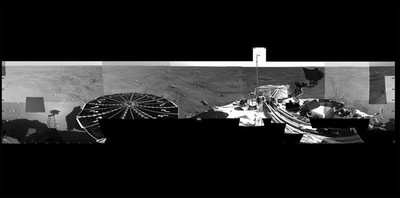Arm Moved For First Time In Nearly One Year
NASA's Mars lander is returning more detailed images from the
Martian surface and is now preparing its instruments for science
operations. Phoenix transmitted a 360-degree panorama of its frigid
Martian world, freed its nearly 8-foot robotic arm, tested a laser
instrument for studying dust and clouds, and transmitted its second
weather report on Wednesday evening.

"We've imaged the entire landing site, all 360 degrees of it. We
see it all," said Phoenix principal investigator Peter Smith,
University of Arizona, Tucson. "You can see the lander in a
fish-eye view that goes all the way out to the entire horizon "We
are now making plans for where to dig first, and what we'll save
for later."
Commands were communicated to Phoenix to rotate the robotic
arm's wrist to unlatch its launch lock, raise the forearm and move
it upright to release the elbow restraint.
"We're pleased that we successfully unstowed the robotic arm. In
fact, this is the first time we have moved the arm in about a
year," said Matthew Robinson of NASA's Jet Propulsion Laboratory in
Pasadena, CA. The arm deployment brings the Phoenix mission to a
significant milestone.
"We have achieved all of our engineering characterization
prerequisites, with all the critical deployments behind us," said
JPL's Barry Goldstein, Phoenix project manager. "We're now at a
phase of the mission where we're characterizing the science payload
instruments. That's a very important step for us."
After a health check that tests the arm at a range of warmer and
colder temperatures, the titanium and aluminum arm will soon be
tasked with its first assignment: to use its camera to look under
the spacecraft to assess the terrain and underside of the
lander.
The robotic arm will later trench into the icy layers of
northern polar Mars and deliver samples to instruments that will
analyze what this part of Mars is made of, what its water is like,
and whether it is or has ever been a possible habitat for life.
Another milestone for the mission included the activation of the
laser instrument called light detection and ranging instrument, or
lidar.
"The Canadians are walking on moonbeams. It's a huge achievement
for us," said Jim Whiteway Canadian Science lead from York
University, Toronto. The lidar is a critical component of Phoenix's
weather station, provided by the Canadian Space Agency. The
instrument is designed to detect dust, clouds and fog by emitting
rapid pulses of green laser-like light into the atmosphere. The
light bounces off particles and is reflected back to a
telescope.

"One of the main challenges we faced was to deliver the lidar
from the test lab in Ottawa, Canada, to Mars while maintaining its
alignment within one one-hundredth of a degree," said Whiteway.
"That's like aiming a laser pointer at a baseball at a distance
from home plate to the center field wall, holding that aim steady
after launch for a year in space, then landing," he added.
Lidar data shows dust aloft to a height of 3.5 kilometers (2
miles). The weather at the Phoenix landing site on the second day
following landing was sunny with moderate dust, with a high of
minus 30 degrees Celsius (minus 22 degrees Fahrenheit) and a low of
minus 80 (minus 112 degrees Fahrenheit).
 ANN's Daily Aero-Linx (04.15.24)
ANN's Daily Aero-Linx (04.15.24) Classic Aero-TV: 'No Other Options' -- The Israeli Air Force's Danny Shapira
Classic Aero-TV: 'No Other Options' -- The Israeli Air Force's Danny Shapira Aero-News: Quote of the Day (04.15.24)
Aero-News: Quote of the Day (04.15.24) Airborne 04.16.24: RV Update, Affordable Flying Expo, Diamond Lil
Airborne 04.16.24: RV Update, Affordable Flying Expo, Diamond Lil ANN's Daily Aero-Term (04.16.24): Chart Supplement US
ANN's Daily Aero-Term (04.16.24): Chart Supplement US




